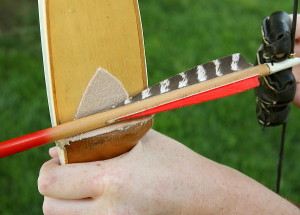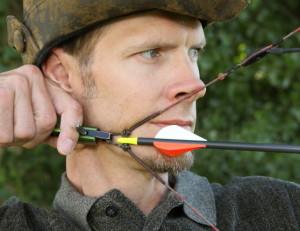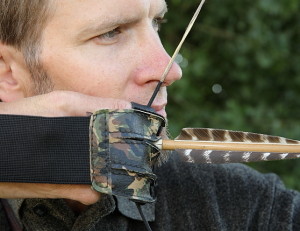How to Release an Arrow: Traditional Recurve and Compound Bow
In this lesson you will learn how to properly release an arrow.
Nocking an Arrow with Traditional Bows
The end of the arrow has a notch in it called an arrow “nock”. The nock attaches to the string just below the “nocking point.” The nocking point is a fixed point on the string that aligns the arrow with the bow for every shot. On most bows, the nocking point is a small brass bead clamped onto the string. The arrow attaches–or nocks–onto the string right below the nocking point. (see photo below)
With traditional archery (longbows and recurves), the arrow has three feathers One feather is a different color and is called the “cock” feather. When you nock an arrow, be sure the cock feather always points out, away from the bow. This keeps the feather from deflecting off the bow. (see photo below)

Nocking an Arrow with Compound Bows
With compound bows, the orientation of the cock “vane” (compound bows have plastic vanes instead of feathers) depends on your arrow rest. The most common arrow rest for compound bows is the drop-away rest. With drop-away rests, the orientation of the cock vane isn’t important as there is no contact with the bow.
With shoot-through, containment style rests like the Whisker Biscuit (as seen below), the cock vane must point upwards. The Whisker Biscuit has stiff bristles on the bottom that support the arrow.

Anchor Point
The next step is to acquire an “anchor point”. Anchor points are two or more spots on your face where your release hand or string comes in contact with your face. Anchor points are vitally important to consistent shooting and accuracy. Therefore you must establish consistent anchor points from the outset.
Anchor points are different for everyone, but most commonly are:
- the string on the tip of your nose
- a finger touching the corner of your mouth
- side of thumb touching your jaw bone
- arrow fletching touching the face
When shooting a compound bow I make sure the string touches the tip of my nose and the side of my thumb touches the back of my jaw.
On traditional bows, the string touches the side of my nose and my first (or middle) finger touches the corner of my mouth.


Note: Many beginner students are afraid to have string contact with their face. This is totally unwarranted because when you release the arrow, all the energy leaves your face unscathed.
Now we are ready to shoot an arrow!
How to Release the Arrow
Here are the steps to releasing an arrow:
- Nock an arrow on the string below the nocking point. You should hear a soft “click” as it locks onto the string. On compound simply attach the mechanical release aid to the D-loop.
- Grasp the string with three fingers. Your three fingers will hook onto the string at the first joints of your fingers.
- Pull the string across your chest, not towards it, and align the string with your eye. Essentially you should split the target with the string and look down the arrow to aim, but keeping your focus on the target, not the arrow.
- Back tension release: As you draw the bow, your back muscles are doing all the work. Squeeze your shoulder blades together as you bring the string to your face. At the same time, you are pushing the bow forward with your bow arm.
- Establish your anchor points on your face.
- Aim with the point of your arrow while looking through the string at the target. With a compound bow, place the appropriate sight pin on the target.
- Release the arrow by simply relaxing and opening your hand. With compound bows you simply touch the trigger of the release.
- Follow through. Follow through means that both arms (bow arm and release arm) continue in opposite directions on the shot. This is called “finishing the shot.” Your release hand should continue straight back towards your ear. The last thing you should feel is your release hand brushing past your face and touching your ear. This will reduce oscillation and increase accuracy.


Final Thought
Archery is a complex skill that cannot be mastered in a day, any more than other muscle-memory skills such as golf or skiing. In the movies they make it look easy, and many of my students have the misconception that they can simply pick up a bow and start hitting bullseyes. But without spending a lot of time on the basics, you’ll immediately develop bad habits which will take a long time to break.
Accuracy comes by focusing on each step, one at a time. After many hours–maybe even months–these steps will gradually become one subconscious step called form. Once proper form is established, your only focus will be on aiming. This is should be your goal.
For previous steps on the archery shot sequence, see:

